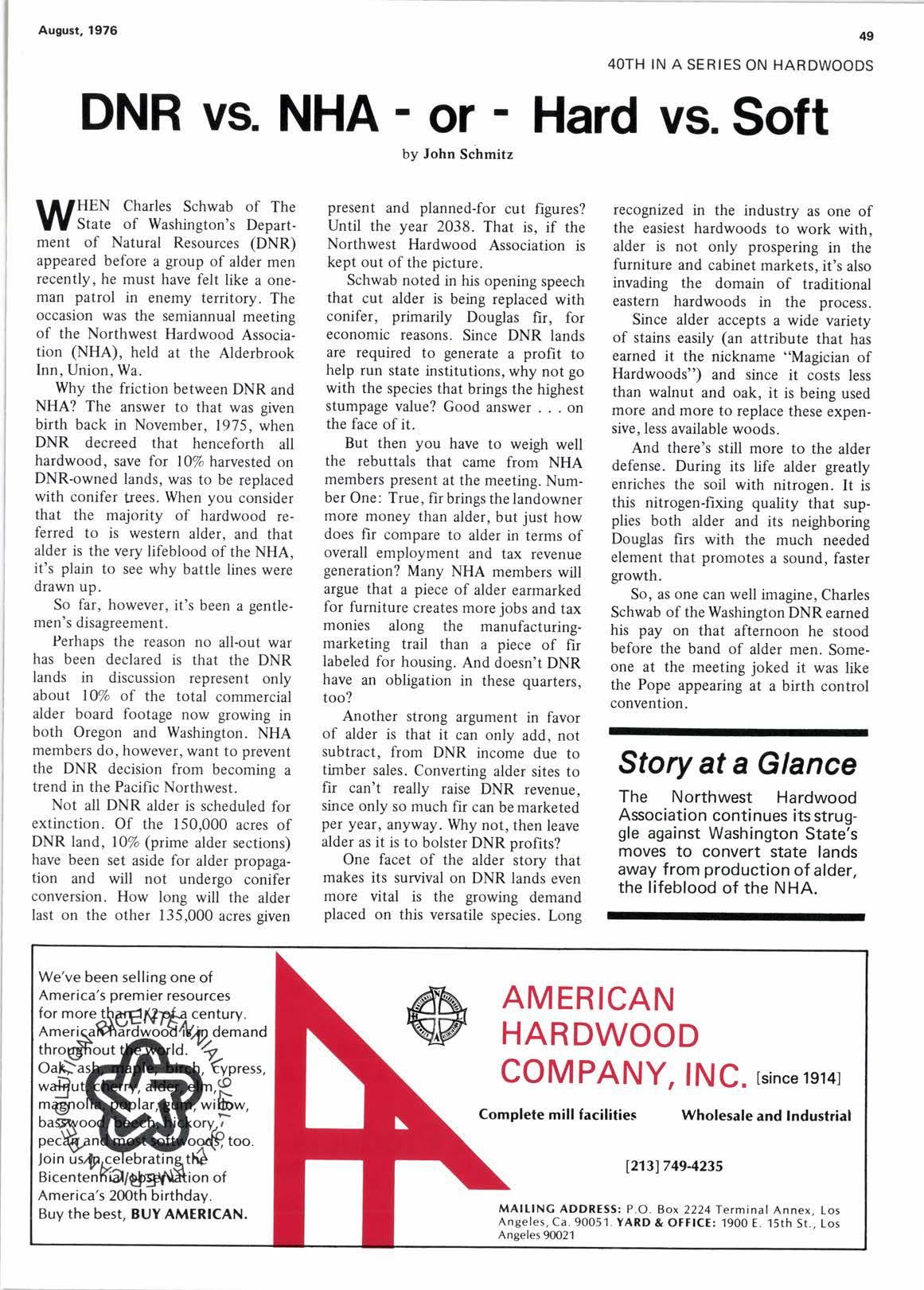
2 minute read
DNR vs. NHA - or r Hard vs. Soft
by John Schmitz
II |HEN Charles Schwab of The
U U State of Washington's Department of Natural Resources (DNR) appeared before a group of alder men recently, he must have felt like a oneman patrol in enemy territory. The occasion was the semiannual meeting of the Northwest Hardwood Association (NHA), held at the Alderbrook Inn, Union, Wa.
Why the friction between DNR and NHA? The answer to that was given birth back in November, 1975, when DNR decreed that henceforth dl hardwood, save for l0% harvested on DNR-owned lands, was to be replaced with conifer trees. When you consider that the majority of hardwood referred to is western alder, and that alder is the very lifeblood of the NHA, it's plain to see why battle lines were drawn up.
So far, however, it's been a gentlemen's disagreement.
Perhaps the reason no all-out war has been declared is that the DNR lands in discussion represent only about lO% of the total commercial alder board footage now growing in both Oregon and Washington. NHA members do, however, want to prevent the DNR decision from becoming a trend in the Pacific Northwest.
Not all DNR alder is scheduled for extinction. Of the 150,000 acres of DNR land, lO% (prime alder sections) have been set aside for alder propagation and will not undergo conifer conversion. How long will the alder last on the other 135,000 acres siven present and planned-for cut figures? Until the year 2038. That is, if the Northwest Hardwood Association is kept out of the picture.
Schwab noted in his opening speech that cut alder is being replaced with conifer, primarily Douglas fir, for economic reasons. Since DNR lands are required to generate a profit to help run state institutions, why not go with the species that brings the highest stumpage value? Good answer . . . on the face of it.
But then you have to weigh well the rebuttals that came from NHA members present at the meeting. Number One: True, fir brings the landowner more money than alder, but just how does fir compare to alder in terms of overall employment and tax revenue generation? Many NHA members will argue that a piece of alder earmarked for furniture creates more jobs and tax monies along the manufacturingmarketing trail than a piece of fir labeled for housing. And doesn't DNR have an obligation in these quarters, too?
Another strong argument in favor of alder is that it can only add, not subtract, from DNR income due to timber sales. Converting alder sites to fir can't really raise DNR revenue, since only so much fir can be marketed per year, anyway. Why not, then leave alder as it is to bolster DNR profits?
One facet of the alder story that makes its survival on DNR lands even more vital is the growing demand placed on this versatile species. Long recognized in the industry as one of the easiest hardwoods to work with, alder is not only prospering in the furniture and cabinet markets, it's also invading the domain of traditional eastern hardwoods in the process.
Since alder accepts a wide variety of stains easily (an attribute that has earned it the nickname "Magician of Hardwoods") and since it costs less than walnut and oak, it is being used more and more to replace these expensive, less available woods.
And there's still more to the alder defense. During its life alder greatly enriches the soil with nitrogen. It is this nitrogen-fixing quality that supplies both alder and its neighboring Douglas firs with the much needed element that promotes a sound, faster growth.
So, as one can well imagine, Charles Schwab of the Washington DNR earned his pay on that afternoon he stood before the band of alder men. Someone at the meeting joked it was like the Pope appearing at a birth control convention.










